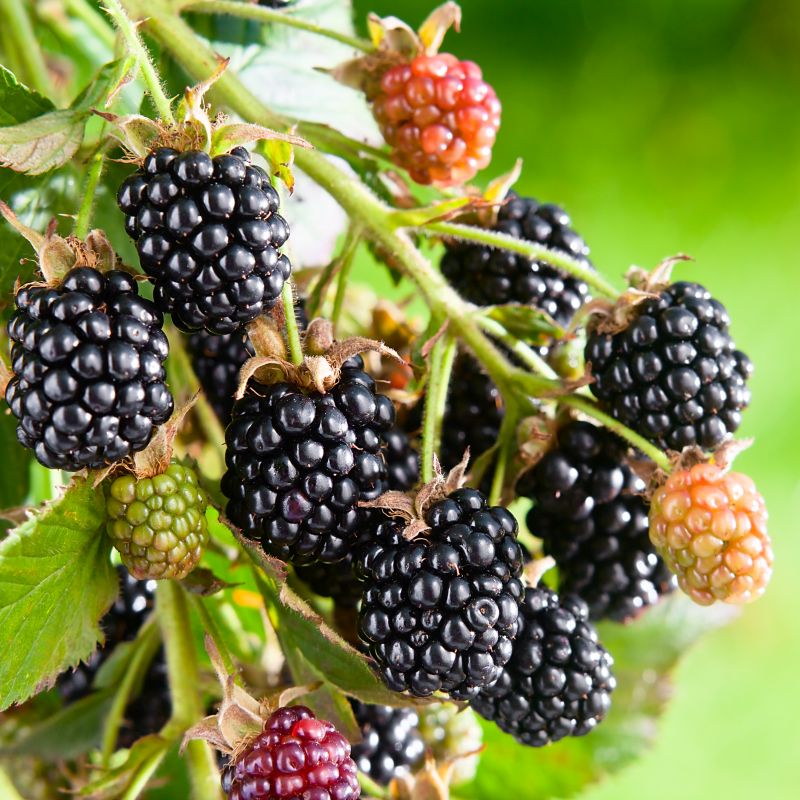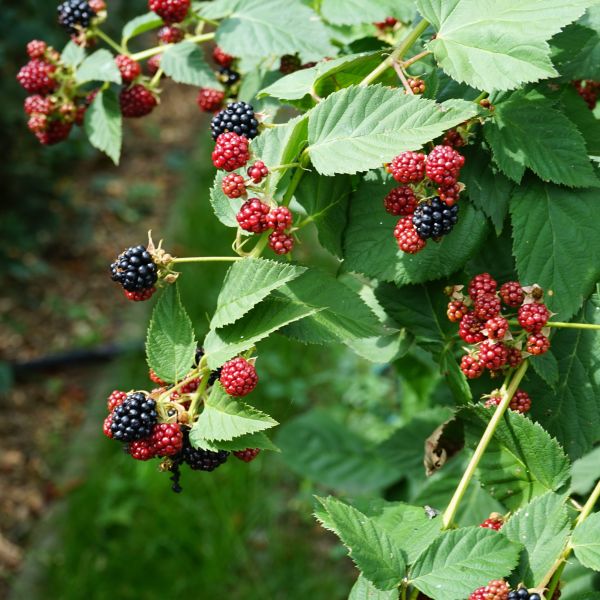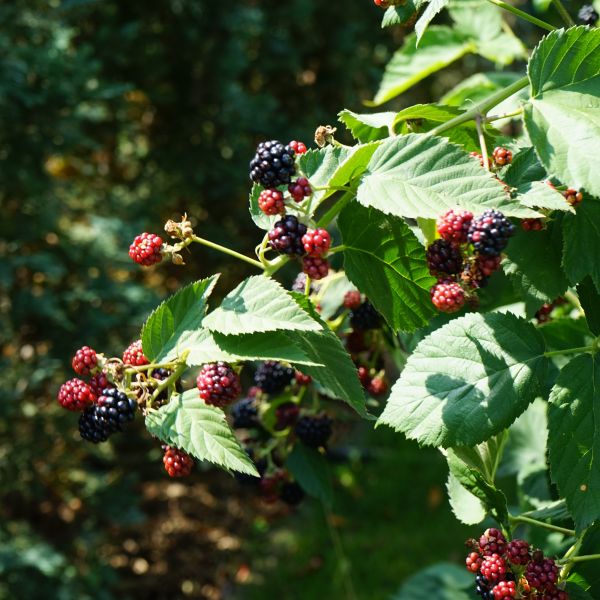


Black Satin Blackberry
Rubus 'Black Satin'
84 reviews
Black Satin Blackberry
Rubus 'Black Satin'
84 reviews
- Large, juicy berries with a sweet, slightly tart flavor
- Thornless canes make for easy picking
- High yield and disease resistance
- Recommended by landscape designers for optimal fit in real yards
$56.00
$80.00
30% Off
- Ships to in 7-10 Days
- Free Shipping Over $150
- Plant Arrival Guarantee
- In Stock
- Free Plant Consult
$200 - Landscape-Approved: Every Plant We Sell Comes With Design Expertise Behind It
1 Gallon
We are sorry, product is currently out of stock due to seasonal availability. Please check the "Related plants available in your area" section below
Not just beautiful - intentionally selected by ShrubHub's 3D landscape design team to fit real-world spaces and maximize yard potential.
Why Black Satin Blackberry?
The Black Satin Blackberry is a popular fruit-bearing shrub known for its large, sweet and flavorful berries that ripen in midsummer. It is a thornless variety, making it ideal for those who enjoy picking the fruit without getting pricked. This plant is also known for its vigorous growth habit, which can grow up to 6 feet tall and require support to prevent the canes from bending under the weight of the fruit.
Sunlight
Black Satin Blackberry plants require full sun exposure to thrive and produce an abundant harvest. This means they need at least six to eight hours of direct sunlight each day to ensure optimal growth and fruiting.
Watering
Black Satin Blackberry plants require regular watering to keep the soil consistently moist but not waterlogged. They benefit from deep, thorough watering once or twice a week, especially during dry periods. Proper hydration is important for healthy growth
Fertilizing
The fertilizer requirement for Black Satin Blackberry may vary depending on the specific soil conditions and individual plant needs. It is recommended to conduct a soil test and consult with local agricultural extension services to determine the exact fert
The Black Satin Blackberry, also known as Rubus subgenus Rubus Watson ‘Black Satin’, is a thornless, heat-tolerant variety of blackberry that is a prolific producer of deep blue-black, juicy berries with a sweet flavor. The thornless blackberries make harvesting much more effective and safe.
Black satin blackberry flowers with small, soft pink flowers followed by black berries that soon become ready for fresh eating.
Blooms start to end in early spring and the semi-erect canes yield a reliable crop of large blackberries in midsummer. The harvest season lasts until late summer.
The plant is cold hardy to USDA cold hardiness zone range 4-9. Black Satin Blackberry is relatively disease-resistant and is one of the ultra-hardy plants. It's also a heat-tolerant blackberry.
Black satin blackberry does, however, require some maintenance when it comes to pruning and molding. With too crowded branches, the fruit doesn't get its edible light requirements in the full sun and wilts. It should also get winter protection.
But otherwise, it only needs a regularly enriched garden soil surface with good air circulation. You can expect extra large fruit the size of golf ball covers as long as it gets direct sunlight under the full sun as it needs in well-drained soil.
Order yours from Shrubhub right away to get a healthy plant to arrive at your doorstep in its best state and ready for the best growth.
Plant Information:
| Botanical Name: | Rubus 'Black Satin' |
| USDA Zones: | 6 - 9 |
| Water: | Medium |
| Exposure: | Full Sun |
| Soil Needs: | Well Drained |
| Mature Height: | 6 feet |
| Mature Spread: | 4 - 6 feet |





Pollination Info
Pollination Information for Black Satin Blackberry
The Black Satin Blackberry (Rubus 'Black Satin') is a self-fertile plant, which means that it can produce fruit without the need for pollination from another plant. However, cross-pollination with another blackberry plant may increase the yield and size of the fruit.
Black Satin blackberries are pollinated by bees and other insects that are attracted to the flowers by their sweet nectar and bright colors. The flowers of the Black Satin Blackberry are usually white or pink in color and bloom from early spring to mid-summer.
It is important to provide a suitable habitat for pollinators to ensure a successful harvest of Black Satin Blackberries. This can be done by planting a variety of flowering plants that bloom at different times throughout the season and avoiding the use of pesticides that may harm bees and other beneficial insects.
If you are planting multiple blackberry varieties, it is recommended to plant them within 100 feet of each other to increase the chances of cross-pollination and improve fruit production.
FAQ
Black Satin Blackberry (Rubus 'Black Satin') - FAQ
Q1. What is a Black Satin Blackberry?
A1. Black Satin Blackberry (Rubus 'Black Satin') is a thornless, semi-erect, and vigorous variety of blackberry. Its fruit is large, sweet, and has a glossy black color.
Q2. How tall will a Black Satin Blackberry plant grow?
A2. A Black Satin Blackberry plant can grow up to 6-8 feet tall and 5-6 feet wide.
Q3. When does Black Satin Blackberry fruit ripen?
A3. Black Satin Blackberry fruit ripens in mid-season, usually in July.
Q4. How do I plant a Black Satin Blackberry plant?
A4. Choose a location that receives full sun and has well-drained soil. Dig a hole twice the size of the plant's root-ball and backfill with a mixture of soil and compost. Water deeply after planting and keep the soil moist.
Q5. How do I care for a Black Satin Blackberry plant?
A5. Water the plant regularly, especially during dry spells or when fruit is forming. Fertilize in early spring and again in early summer with a balanced fertilizer. Prune after fruiting by removing the older canes to encourage new growth.
Q6. Are Black Satin Blackberries self-pollinating?
A6. Yes, Black Satin Blackberries are self-pollinating. However, planting multiple varieties can increase the yield and fruit quality.
Q7. Are Black Satin Blackberries resistant to diseases?
A7. Black Satin Blackberries are resistant to some common diseases such as rust and powdery mildew. However, they can still be susceptible to other diseases such as anthracnose and canker.
Q8. How do I harvest Black Satin Blackberries?
A8. Pick the fruit when it is fully black and easily comes off the plant. Harvest every 2-3 days when the fruit is ripening.
Q9. Can I grow Black Satin Blackberries in containers?
A9. Yes, Black Satin Blackberries can be grown in containers as long as the container is at least 18 inches in diameter and depth. Provide support for the plant to grow on.
Q10. What are some common uses for Black Satin Blackberries?
A10. Black Satin Blackberries can be eaten fresh, used in desserts, jams, sauces, and in smoothies. They are also a great addition to salads.
Planting & Care
Planting & Care for Black Satin Blackberry (Rubus 'Black Satin')
- Choosing a Location: Black Satin Blackberry grows best in well-drained soil that receives full sun, and is sheltered from strong winds. Choose a location where the plant can receive at least 6 hours of direct sunlight a day.
- Preparing the Soil: Before planting, dig a hole twice as wide and just as deep as the plant's rootball. Mix compost, peat moss, or well-rotted manure into the soil to improve water retention and drainage.
- Planting: Plant black satin blackberry in early spring or late fall, spacing plants about 3-4 feet apart. Water the plant well after planting, and mulch around the base of the plant to help conserve moisture.
- Watering: Black Satin Blackberry requires moderate watering, with deep watering once or twice a week, depending on rainfall and soil moisture. If the leaves begin to wilt, it is a sign that the plant needs more water.
- Pruning: In early spring, before new growth appears, prune out any damaged or weak canes. Summer-bearing varieties should be pruned in late winter or very early spring, while everbearing varieties should be pruned in late summer or early fall.
- Fertilizing: Apply a balanced fertilizer, such as 10-10-10, in early spring and again in early summer. Be careful not to over-fertilize or the plant may produce too much leafy growth at the expense of fruit development.
- Pest and Disease Control: Black Satin Blackberry is relatively resistant to pests and disease, but may be susceptible to cane borers, aphids, and powdery mildew. Control pests and diseases with organic or chemical treatments as necessary.
Following these planting and care instructions should result in a healthy, productive Black Satin Blackberry plant that provides a bountiful harvest of sweet, juicy berries.
Check Out These Verified Customer Reviews:
Customer Reviews
4.7 out of 5 based on 84 reviews
Thank you! Your review has been submitted.
Great quality and taste
Shipment was prompt and hassle-free, received my order in just a few days.
Beautiful and delicious blackberries
Item has been added to your cart.


